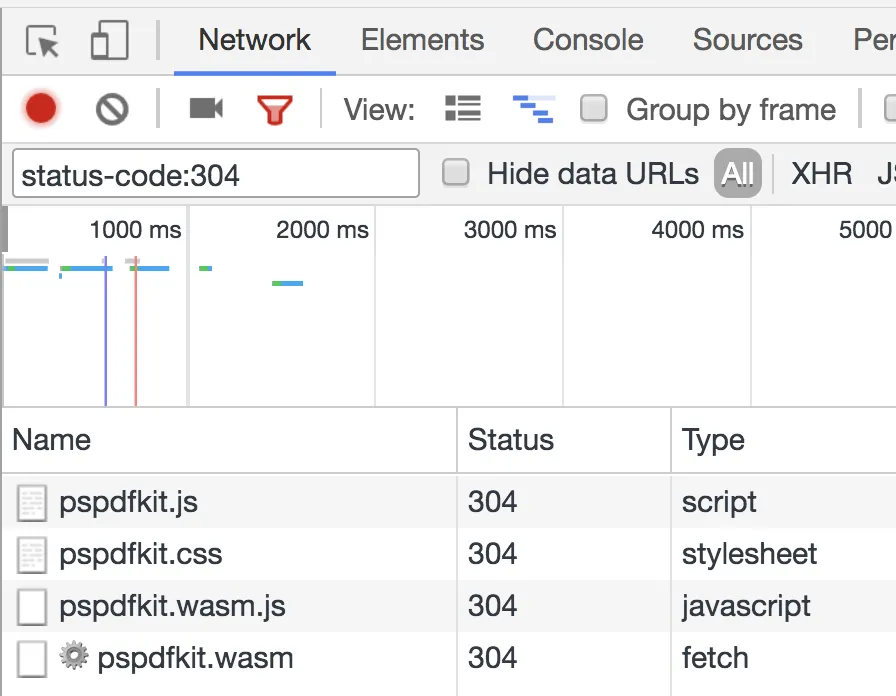Optimizing WebAssembly Startup Time
Table of contents

WebAssembly is the future, and at PSPDFKit, we truly believe in it. So much so that, in 2017, we launched a serverless version of our PDF viewer and framework that’s completely based on WASM.
Thanks to this technology, in addition to the existing server-based product, we’re able to ship our C++ rendering engine and PDF processor to browsers and give our customers the opportunity to deliver a standalone solution that doesn’t require a complex backend infrastructure.
Since that 2017 release, our efforts have been focused on reducing WebAssembly startup time, because it’s the very first thing that impacts our end users who opt for standalone deployment.
Don’t miss the first part of our series: WebAssembly: A New Hope
Bottlenecks
Depending on the size of the WebAssembly module, the process of creating an instance of it(opens in a new tab) can often take several seconds — usually in the order of tens.
More specifically, the initialization process consists of three steps — download, compile, and instantiation — that individually affect the overall load time.
<div id="bench" style="font-size: 0.8em"> <button class="btn btn-md btn-brand">⏱ Test loading time in your browser</button> </div> <script type="text/javascript" src="/assets/images/blog/2018/optimize-webassembly-startup-performance/bench.js"></script>
Optimizations
However, with relatively little work, it’s possible to get significant speed improvement.
To demonstrate this, we’ll provide an overview of four simple but effective solutions we currently employ in PSPDFKit for Web to speed up each individual step, including:
- asset caching
- compilation, and how to cache compiled
.wasmmodules - classic instantiation and streaming instantiation
- caching initialized instances
Download
Since .wasm modules are regular files, it’s important to make sure they’re cached by the browser. This is a very common — and basic if you will — practice when serving assets over the network. In doing so, repeated requests to the same resource can be served from the local resources cache immediately rather than being transferred over the network.
For this to work, each server response needs to include the correct Cache-Control HTTP header for the transferred resource, which tells the browser how long the resource should be cached. In this blog post(opens in a new tab), Ilya Grigorik from Google does a great job at explaining how HTTP caching works. I highly recommend you read it in case you aren’t familiar with the topic.
Determining whether or not assets are being served from the browser cache is fairly simple. After opening the developer tools, select the Network panel and refresh the page. Cached assets will have the response status code 304.

Please make sure the cache is not disabled when the developer tools are open. Otherwise, resources will never be served from the local cache.
Once our cache is properly configured, we might want to make sure our server compresses each resource to reduce its size before transmitting it over the network. This is commonly referred as gzipping, and it’s supported by all modern browsers. In fact, browsers automatically negotiate GZIP compression for all HTTP requests.
Finally, with service workers, it’s possible to serve .wasm modules offline and immediately. The Google Developers site has a worthwhile article on the topic(opens in a new tab), which you should definitely check out.
Compiling and Caching
Once the WebAssembly binary is downloaded, we need to compile it to a WebAssembly.Module(opens in a new tab) before we can create instances of it.
This can be done using the WebAssembly.compile() function, which takes a typed array or ArrayBuffer containing the binary code of the .wasm module we want to compile, and returns a Promise that resolves to a WebAssembly.Module object representing the compiled module:
const response = await fetch('module.wasm');const buffer = await response.arrayBuffer();const module = await WebAssembly.compile(buffer);
doSomethingWith(module);fetch('module.wasm') .then(function (response) { return response.arrayBuffer(); }) .then(function (buffer) { WebAssembly.compile(buffer); }) .then(function (module) { doSomethingWith(module); });WebAssembly.instantiate() can also compile our WebAssembly binary code and then create an instance immediately. We’ll look into this in the next section.
Regardless of which method we use to compile our .wasm module, this step represents the major bottleneck when using WebAssembly, and it might be very time consuming. In our case, it averages 4s on a modern machine with 16 GB of memory.
The good news is that modern browsers ship with IndexedDB(opens in a new tab), an API for client-side storage, which we can use to cache compiled WebAssembly modules.
As of January 2018, Firefox and Chrome (Canary, under feature flag. See: chrome://flags) support WebAssembly-structured cloning(opens in a new tab), which allows for storing the compiled WebAssembly.Module in IndexedDB. In MSEdge, IndexedDB seems to only be working on the main thread (not in web workers).
Although IndexedDB is a transactional database system like an SQL-based RDBMS, it allows you to store and retrieve objects that are indexed with a key.
In our case, the key will be the version of our .wasm module, and the value will be the compiled module itself. Whenever we change the module version, we can ignore the cached value and recompile.
In a real application, another option is to use a checksum of the .wasm file instead of a module version.
It’s also important to delete outdated versions of the module from the database. For simplicity’s sake, we suggest deleting every record from the database before caching a new version of the module.
Keep in mind that, for security reasons, browsers don’t allow local files to access IndexedDB databases. As such, our application needs to run on a web server.
During the rest of this post, we’ll use a getCache helper that uses IndexedDB under the hood. You can take a look at its implementation on GitHub(opens in a new tab). Please keep in mind that getCache is a simplified and non-production-ready abstraction.
Once we have a simple interface to IndexedDB, caching our compiled module is straightforward.
Using our helper and the MODULE_VERSION, we look up the cache to see if we have a compiled module. If not, we fetch the actual .wasm module, compile it, and put it in the cache before returning it. Finally, we can call WebAssembly.instantiate with the compiledModule:
const MODULE_VERSION = 1;const cache = await getCache('WASMCache');let compiledModule = await cache.get(MODULE_VERSION);
if (!compiledModule) { /** * 1. Fetch the module * 2. Compile it * 3. Put it in the cache * 4. Return the compiled module */ const response = await fetch('module.wasm'); const buffer = await response.arrayBuffer(); compiledModule = await WebAssembly.compile(buffer);
cache.put(MODULE_VERSION, compiledModule);}
// Once we have the compiled module, we can instantiate it.const module = await WebAssembly.instantiate(compiledModule, imports);var MODULE_VERSION = 1;var cache;
getCache('WASMCache') .then(function (_cache) { cache = _cache; return cache.get(MODULE_VERSION); }) .then(function (compiledModule) { // Return the cached compiled module. if (compiledModule) { return compiledModule; }
/** * 1. Fetch the module * 2. Compile it * 3. Put it in the cache * 4. Return the compiled module */ return ( fetch('module.wasm') .then(function (response) { return response.arrayBuffer(); }) // Compile the module. .then(function (buffer) { return WebAssembly.compile(buffer); }) .then(function (compiledModule) { cache.put(MODULE_VERSION, compiledModule); return compiledModule; }) ); }) // Once we have the compiled module, we can instantiate it. .then(function (compiledModule) { return WebAssembly.instantiate(compiledModule, imports); });Instantiation
Instantiation is the process of creating an instance of a WebAssembly.Module.
When this step is separate from compilation, it might be worth measuring its impact on the overall loading time before doing any (micro)optimization. In many cases in fact, instantiation is fast enough.
But as we mentioned above, WebAssembly.instantiate() can also compile .wasm modules. The method takes the WebAssembly binary code in the form of a typed array or ArrayBuffer and performs both compilation and instantiation in one step.
In this case, we can adapt our caching snippet to work with WebAssembly.instantiate():
const MODULE_VERSION = 1;const cache = await getCache('WASMCache');let compiledModule = await cache.get(MODULE_VERSION);
// [new] Create an instance of a `WebAssembly.Module`.if (compiledModule) { return WebAssembly.instantiate(compiledModule, imports);}
/** * 1. Fetch the module. * 2. [new] Compile it and create an instance. * 3. Put the compiled `WebAssembly.Module` in the cache. * 4. Return the compiled module. */const response = await fetch('module.wasm');const buffer = await response.arrayBuffer();// [new] Compile and instantiate the module.const result = await WebAssembly.instantiate(buffer, imports);
// Cache the compiled module.cache.put(MODULE_VERSION, result.module);
// Return an instance of it.return result.instance;var MODULE_VERSION = 1;var cache;
getCache('WASMCache') .then(function (_cache) { cache = _cache; return cache.get(MODULE_VERSION); }) .then(function (compiledModule) { // [new] Create an instance of a `WebAssembly.Module`. if (compiledModule) { return WebAssembly.instantiate(compiledModule, imports); }
/* * 1. Fetch the module. * 2. [new] Compile it and create an instance. * 3. Put the compiled `WebAssembly.Module` in the cache. * 4. Return the instance. */ return ( fetch('module.wasm') .then(function (response) { return response.arrayBuffer(); }) // [new] Compile and instantiate the module. .then(function (buffer) { return WebAssembly.instantiate(buffer, imports); }) .then(function (result) { // Cache the compiled module. cache.put(MODULE_VERSION, result.module); // Return an instance of it. return result.instance; }) ); });Streaming Instantiation: Combining Download and Instantiation
The ultimate optimization nowadays is streaming instantiation, which allows WebAssembly to compile as the payload is downloaded.
This improvement has a significant impact on the initial compile time, and it allows applications to hide the cost of compiling behind download costs.
As of July 2022, all modern web browsers(opens in a new tab) support WebAssembly.instantiateStreaming.
At PSPDFKit, we use streaming compilation and fall back to traditional compilation when it isn’t supported.
When the compiled module isn’t cached, we create a fetch promise to download the file, and if WebAssembly.instantiateStreaming is supported, we invoke it with the promise and the module imports. When streaming instantiation isn’t supported, we use the fetch promise regularly and then instantiate the module separately:
const MODULE_VERSION = 1;const cache = await getCache('WASMCache');let compiledModule = await cache.get(MODULE_VERSION);
// [new] Create an instance of a `WebAssembly.Module`.if (compiledModule) { return WebAssembly.instantiate(compiledModule, imports);}
// [new]
const fetchPromise = fetch('module.wasm');
let instantiatePromise;
// Detect support for `WebAssembly.instantiateStreaming`.const isInstantiateStreamingSupported = typeof WebAssembly.instantiateStreaming == 'function';
if (isInstantiateStreamingSupported) { // Streaming supported. instantiatePromise = WebAssembly.instantiateStreaming( fetchPromise, imports, );} else { // No streaming supported — old method. instantiatePromise = fetchPromise .then((response) => response.arrayBuffer()) .then((buffer) => WebAssembly.instantiate(buffer, imports));}
const result = await instantiatePromise;
// Cache the compiled module.cache.put(MODULE_VERSION, result.module);// Return an instance of it.return result.instance;var MODULE_VERSION = 1;var cache;
getCache('WASMCache') .then(function (_cache) { cache = _cache; return cache.get(MODULE_VERSION); }) .then(function (compiledModule) { if (compiledModule) { return WebAssembly.instantiate(compiledModule, imports); }
// [new]
const fetchPromise = fetch('module.wasm'); let instantiatePromise;
// Detect support for `WebAssembly.instantiateStreaming`. const isInstantiateStreamingSupported = typeof WebAssembly.instantiateStreaming == 'function';
if (isInstantiateStreamingSupported) { // Streaming supported. instantiatePromise = WebAssembly.instantiateStreaming( fetchPromise, imports, ); } else { // No streaming supported — old method. instantiatePromise = fetchPromise .then(function (response) { return response.arrayBuffer(); }) .then(function (buffer) { return WebAssembly.instantiate(buffer, imports); }); }
return instantiatePromise.then(function (result) { // Cache the compiled module. cache.put(MODULE_VERSION, result.module); // Return an instance of it. return result.instance; }); });As a side note, with streaming instantiation, now .wasm files must be served with the correct Content-Type header, which is application/wasm. When the server isn’t configured to do so, you might get Unhandled promise rejection TypeError: Response has unsupported MIME type.
Mozilla recommends using instantiateStreaming(opens in a new tab) where possible, because WebKit’s JSC engine has some performance issues with compileStreaming.
We pulled out some numbers to compare the initialization time of PSPDFKit for Web with and without streaming. On average, streaming initialization is 1.8 times faster in Firefox.
With streaming instantiation:
Start https://de.stable.our.services.nutrient-powered.io/pspdfkit.wasm download.Download and instantiation complete, took 955ms.Native initialization complete, took 1,144ms.Without streaming instantiation:
Start https://de.stable.our.services.nutrient-powered.io/pspdfkit.wasm download.Download complete, took 667ms.Compilation and instantiation complete, took 1,119ms.Native initialization complete, took 2,013ms.Object Pooling — Caching Instances
In the single-page application era, it might be common to create and destroy WebAssembly.Module instances multiple times during the lifecycle of an application.
This process can add some overhead, especially when compiled modules aren’t cached permanently using IndexedDB. In the worst case, an application will start the entire initialization process (download, compile, instantiate) from scratch every time it needs to use the .wasm module.
When this occurs, an object pool(opens in a new tab) can be a decent solution to speed up the subsequent creation of instances. In fact, after the initial download, compilation, and instantiation, the warmed up WebAssembly.Module instances can be kept in memory and reused at any time.
The object pool holds a fixed number of instances in memory and returns one when we ask for it. If none are available, it creates a new instance and returns it.
When we no longer need an instance, we can put it back in the pool, which will either recycle it (do some cleanup) and keep it alive, or destroy it, i.e. defer the object to garbage collection for cleanup when the pool is full.
Each instance must implement a simple Recyclable interface that defines a recycle and destroy method:
interface Recyclable { destroy(): void; recycle(): void;}An object pool can be used at any level in an application to keep things in memory and ready to use. For example, it could be employed to cache the entire web worker in which we run our WebAssembly code, or it could just cache an instance of a WebAssembly module.
At PSPDFKit, we use object pooling to cache our WebAssembly backend, which runs in a web worker. This allows for fast instance creation when opening new PDFs.
Conclusion
Although WebAssembly is a fairly new and cutting-edge technology, it has already been employed in production applications like PSPDFKit for Web.
Getting startup time of our application down to 200 – 300ms (best case) is already achievable since most of the following optimizations are already possible:
- Making sure the
.wasmfile is properly cached - Using streaming instantiation
- Caching compiled WebAssembly modules in IndexedDB
- Using object pooling to cache warmed-up instances
In fact, with our most recent release, we implemented IndexedDB caching and streaming instantiation in PSPDFKit for Web and our customers are already benefitting from these improvements.
During the past year, Mozilla has invested a lot into making WebAssembly awesome and fast, and we believe other vendors will follow along. We’re looking forward to it!
As a final note to our customers, we also offer the possibility of using asm.js. While some of the optimizations above cannot be implemented when using asm.js, the startup time is usually faster than (unoptimized) .wasm.
Don’t miss the first part of our series: WebAssembly: A New Hope
FAQ
WebAssembly (WASM) is a binary instruction format that allows code to run at near-native speed in web browsers. It significantly improves PDF rendering by enabling complex tasks to be performed efficiently without relying on a backend server.
Asset caching ensures that WebAssembly modules are stored locally in the browser, reducing the need to download them again. This leads to faster startup times as the cached modules can be loaded instantly from the local storage.
IndexedDB is used to cache compiled WebAssembly modules, allowing them to be quickly retrieved and instantiated without recompiling. This reduces the time needed for startup, especially in repeated uses of the same modules.
Streaming instantiation allows WebAssembly modules to be compiled while they are being downloaded. This parallel process reduces the overall load time, making applications faster to initialize and more responsive to user interactions.
Object pooling involves reusing WebAssembly instances instead of creating new ones each time they are needed. This approach minimizes the overhead of initialization and improves performance by keeping instances in memory for quick access.
ℹ️ Note: This blog post was updated in July 2022.







